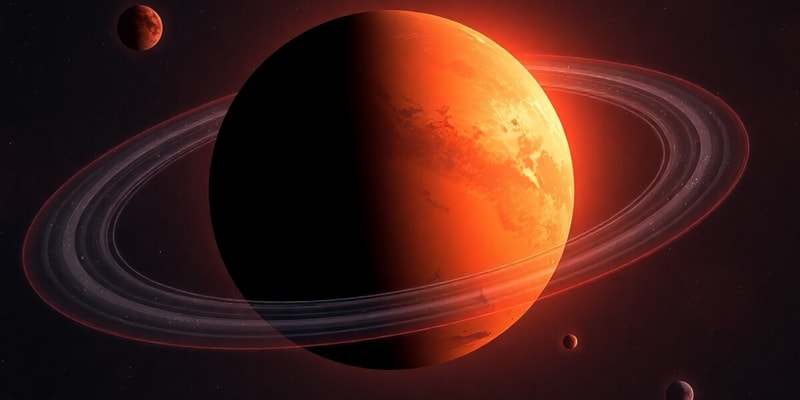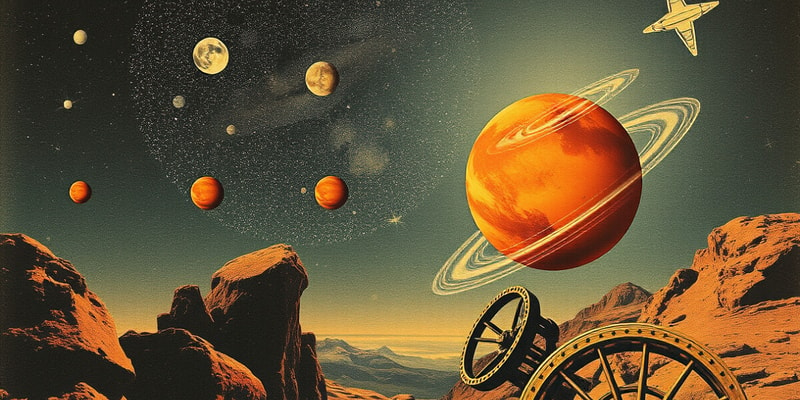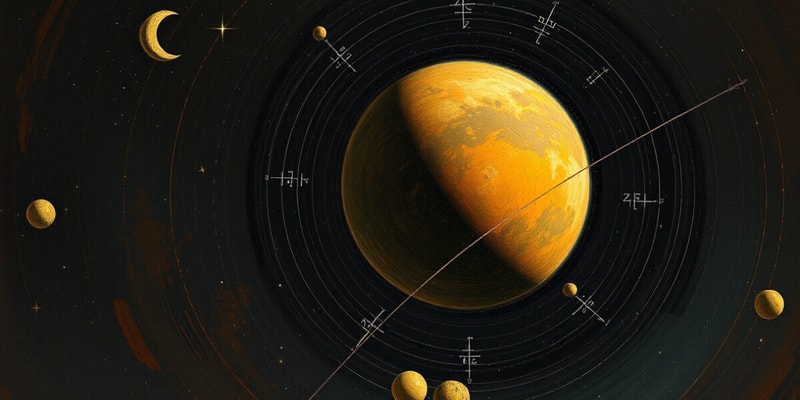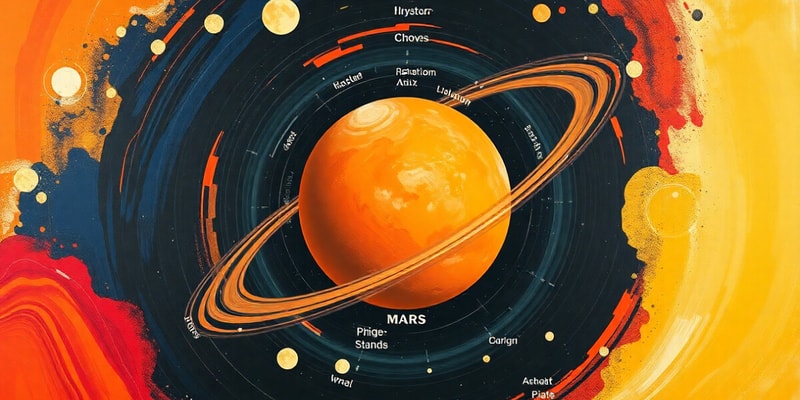Podcast
Questions and Answers
The orbits are ______
The orbits are ______
ellipses
A body at rest will remain at rest, and a body in motion will remain in ______
A body at rest will remain at rest, and a body in motion will remain in ______
motion
Planets cover equal areas in equal ______
Planets cover equal areas in equal ______
time
A planet’s orbital period is proportional to the size of its ______
A planet’s orbital period is proportional to the size of its ______
Signup and view all the answers
The acceleration of the object is directly proportional to the ______
The acceleration of the object is directly proportional to the ______
Signup and view all the answers
The higher mass, the more ______
The higher mass, the more ______
Signup and view all the answers
The force exerted by object 1 upon object 2 is equal in magnitude and opposite in direction to the force exerted by object 2 upon ______
The force exerted by object 1 upon object 2 is equal in magnitude and opposite in direction to the force exerted by object 2 upon ______
Signup and view all the answers
If the distance ______ decreases, attraction will increase.
If the distance ______ decreases, attraction will increase.
Signup and view all the answers
Henry Cavendish proved the value of G = 6.67 x 10-11 N m²/kg², which is known as the universal ______.
Henry Cavendish proved the value of G = 6.67 x 10-11 N m²/kg², which is known as the universal ______.
Signup and view all the answers
In physics, a ______ is described as having both magnitude and direction.
In physics, a ______ is described as having both magnitude and direction.
Signup and view all the answers
According to the law of ______, an object in motion stays in motion unless acted upon by an external force.
According to the law of ______, an object in motion stays in motion unless acted upon by an external force.
Signup and view all the answers
In an elevator that is accelerating upward, the perceived ______ will be greater than normal.
In an elevator that is accelerating upward, the perceived ______ will be greater than normal.
Signup and view all the answers
EINSTEIN’S THEORY OF ______ challenged Newton’s picture of universal gravitation.
EINSTEIN’S THEORY OF ______ challenged Newton’s picture of universal gravitation.
Signup and view all the answers
According to Einstein, gravity is not a force but rather an effect; a distortion in the shape of ______ due to mass.
According to Einstein, gravity is not a force but rather an effect; a distortion in the shape of ______ due to mass.
Signup and view all the answers
The formula for calculating force is ______ = mass × acceleration.
The formula for calculating force is ______ = mass × acceleration.
Signup and view all the answers
The distinction between a hypothesis, a theory, and a ______ is important in scientific discourse.
The distinction between a hypothesis, a theory, and a ______ is important in scientific discourse.
Signup and view all the answers
During free-fall, an object experiences ______, resulting in a sensation of zero weight.
During free-fall, an object experiences ______, resulting in a sensation of zero weight.
Signup and view all the answers
Examples of ______ include displacement, velocity, acceleration, and force.
Examples of ______ include displacement, velocity, acceleration, and force.
Signup and view all the answers
In special relativity, the effects are compared from different observer positions in terms of ______ or speed in a particular direction.
In special relativity, the effects are compared from different observer positions in terms of ______ or speed in a particular direction.
Signup and view all the answers
In case 3 of the elevator dilemma, when going down, the weight experienced is ______.
In case 3 of the elevator dilemma, when going down, the weight experienced is ______.
Signup and view all the answers
Swimming involves pushing the fluid ______ to swim forward.
Swimming involves pushing the fluid ______ to swim forward.
Signup and view all the answers
The celestial ______ has a perfect shape.
The celestial ______ has a perfect shape.
Signup and view all the answers
Tycho Brahe observed the ______ of Jupiter, demonstrating that they are not unique to Earth.
Tycho Brahe observed the ______ of Jupiter, demonstrating that they are not unique to Earth.
Signup and view all the answers
Kepler developed simple laws that accounted for ______ observations.
Kepler developed simple laws that accounted for ______ observations.
Signup and view all the answers
Newton introduced the terms perihelion and ______ in relation to planetary orbits.
Newton introduced the terms perihelion and ______ in relation to planetary orbits.
Signup and view all the answers
Johannes Kepler's first law states that planets move in ______ orbits around the sun.
Johannes Kepler's first law states that planets move in ______ orbits around the sun.
Signup and view all the answers
Stellar parallax is not observable because stars are ______ away.
Stellar parallax is not observable because stars are ______ away.
Signup and view all the answers
Isaac Newton's contributions include calculus, optics, and the laws of ______.
Isaac Newton's contributions include calculus, optics, and the laws of ______.
Signup and view all the answers
In heliocentrism concerns, it was noted that we do not feel the ______ of the Earth.
In heliocentrism concerns, it was noted that we do not feel the ______ of the Earth.
Signup and view all the answers
The apparent change in the direction of the motion of Mars is known as ______ motion.
The apparent change in the direction of the motion of Mars is known as ______ motion.
Signup and view all the answers
Eudoxus created the first model of a ______ Universe.
Eudoxus created the first model of a ______ Universe.
Signup and view all the answers
Eudoxus' model included concentric circles called ______.
Eudoxus' model included concentric circles called ______.
Signup and view all the answers
Small circles with centers that move along the deferent are known as ______.
Small circles with centers that move along the deferent are known as ______.
Signup and view all the answers
The Heliocentric Model was proposed by ______ of Samos.
The Heliocentric Model was proposed by ______ of Samos.
Signup and view all the answers
According to Copernicus, planets have uniform circular orbits around the ______.
According to Copernicus, planets have uniform circular orbits around the ______.
Signup and view all the answers
Inferior Planets include ______ and Venus.
Inferior Planets include ______ and Venus.
Signup and view all the answers
Superior Planets consist of Mars, Jupiter, and ______.
Superior Planets consist of Mars, Jupiter, and ______.
Signup and view all the answers
Study Notes
Retrograde Motion and Early Models
- Retrograde motion of Mars is the apparent backward movement due to the differing speeds of Earth and Mars.
- Eudoxus of Cnidus proposed the first geocentric model, asserting that celestial bodies travel in uniform circular orbits around Earth.
- His model included concentric circles (deferents), small circles (epicycles), and an imaginary point called equant for motion variations.
- He noted changes in brightness and size of celestial bodies but could not reconcile these with his model.
Heliocentric Model
- Aristarchus of Samos introduced the heliocentric model with Earth and planets orbiting a fixed Sun, proposing that the Moon orbits Earth.
- Stellar parallax reflects the apparent shift of distant objects due to Earth's motion.
- Nicolaus Copernicus refined the heliocentric theory, emphasizing uniform circular orbits around the Sun, with Earth at a faster orbital speed leading to retrograde motion.
Important Contributions from Astronomers
- Claudius Ptolemy enhanced the geocentric model but failed to explain retrograde motion satisfactorily and could not observe stellar parallax due to distance.
- Tycho Brahe conducted precise astronomical observations before telescopes, discovering lunar craters, sunspots, moons of Jupiter, and phases of Venus, implying a broader view of the cosmos.
- Johannes Kepler formulated three laws of planetary motion, providing evidence for elliptical orbits and relationships between a planet's distance from the Sun and its orbital period.
Newton's Fundamental Laws and Gravitation
- Isaac Newton introduced laws of motion and universal gravitation, explaining gravitational forces as proportional to masses and inversely proportional to the square of the distance between objects.
- He defined key terms such as perihelion (closest point to the Sun) and aphelion (farthest point), clarifying planetary movements.
Laws of Motion
- Newton's First Law (Law of Inertia): An object remains at rest or in uniform motion unless acted upon by a net external force.
- Newton's Second Law (Law of Acceleration): Force equals mass times acceleration (F=ma), demonstrating the relationship between force, mass, and acceleration.
- Newton's Third Law (Law of Action and Reaction): For every action, there is an equal and opposite reaction; forces between two objects are equal in magnitude and opposite in direction.
Vectors and Scalars
- Scalars are quantities with magnitude only, whereas vectors have both magnitude and direction.
- Examples of vectors include velocity, acceleration, and force.
Einstein’s Relativity
- Albert Einstein challenged Newton's gravitational framework with his theory of relativity.
- Special relativity analyzes physical effects from different observers' perspectives regarding speed and direction.
- General relativity describes gravity as the curvature of space caused by mass, rather than a traditional force.
Definitions of Scientific Concepts
- Hypothesis: An educated guess or preliminary explanation of phenomena.
- Law: A statement describing what happens under specific conditions based on repeated trials.
- Theory: A well-substantiated explanation of certain phenomena, providing insights into why events occur.
Studying That Suits You
Use AI to generate personalized quizzes and flashcards to suit your learning preferences.
Description
This quiz covers the concept of retrograde motion specifically related to Mars. It explains the phenomena where Mars appears to change its direction due to differences in motion relative to Earth. Ideal for students studying the physical world in science class.




